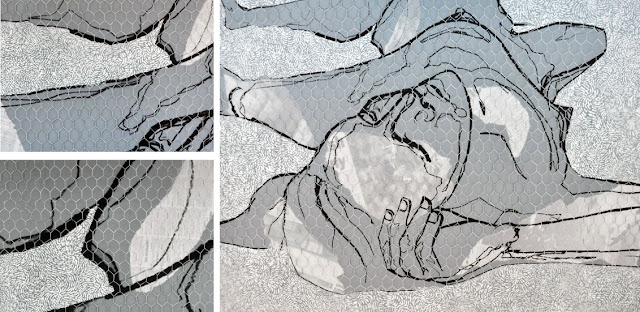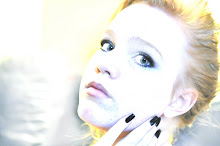[Digitally manipulated photograph]
Reflections relies heavily on the form of found objects. The objects used are small circular pieces of paper discarded from a hole punch, usually considered rubbish and not given a second thought. My work gives this very ordinary everyday office supply a second life. I have chosen to use a man made material and arranged them in such a way that they create organic shapes. In my photo I have captured the reflections of these, in so doing creating these more organic forms and highlighting this idea of nature reflected in our built environment.
Spiderscope:
Spider webs are naturally occurring lines that form intricate geometric shapes. A single strand is stronger than a piece of steel the same thickness. This series serves to highlight the simultaneously delicate yet powerful nature of our environment.
The linear, the positive, the negative:
[Black acrylic on canvas with colourful paper dots]
An exploration of the female form originally a drawing created in a session of life drawing transformed through the use of found objects.
Topography:
[Layered paper cut]
Cartography (map drawing) is in essence the way that we study and map out our surroundings, although it is inherently an abstract form. Here I focus on the interesting form of contour maps and the way that lines are used to represent an environment where all aspects are ultimately interconnected.
Shadow Lines:
[Mixed media installation pie dishes, glue, 2 x bike wheels and fishing wire]
In the book Shadow Lines by Indigenous author Stephen Kinnane it talks about the way we occupy the same space but have different ‘place memories’ of it. This space represents the ghostly nature of a memory and the liminal spaces that combine to make the whole. Here it is the space between that is highlighted as the place in, which each person can co-exist.
[Digitally manipulated photograph on tracing paper]
Relationship to environment shapes identity. This work is inspired by traditional Indigenous body painting as an expression of connection to place and land. I have chosen digital photography to communicate the way that we relate and connect to our environment within this technological age. This work observes my brother and his connection to place: alone, in the dark, in his room, playing video games. The only natural light source forms small dots of light on his body highlighting his connection to his place and therefore his identity.
Redlining:
[Mixed media gouache, paper, wire and charcoal drawing reprinted on tracing paper]
Redlining was a term used in America in the 1960s to describe the practice of marking a red line on a map to delineate the area where banks would not invest; later the term was applied to discrimination against a particular group of people no matter the geography. The layer of wire is symbolic of the way we segregate and discriminate against people. There is no visible red line used within the work because this practice is overlooked and becomes invisible.
Segregation:
[Mixed media digital photograph, tracing paper and gouache on paper]
This work extends on the ideas of segregation represented in Redlining although photography is used to enhance the portrayal of the emotional response of the subject.
Integration:
[Digitally created image incorporating mixed media elements of drawing and photography]
Integration was an early exploration of geometric shapes particularly circles and hexagons combined with photographs of elements seen in my installation Shadow Lines.
Liberation:
[Photograph of Mixed media work charcoal, acrylic paint and tracing paper]
This work was part of my original experimentation with drawing and tracing paper leading to the Segregation series. Originally created on a purple background with small painted dots showing through from behind.
Kaleidoscope:
[Digitally manipulated photography on translucent paper]
A kaleidoscope exists within a small cylindrical tunnel yet creates an environment of limitless space and endless possibility. The definition of the word kaleidoscope is a constantly changing pattern or sequence of objects- there is order within the chaos.













